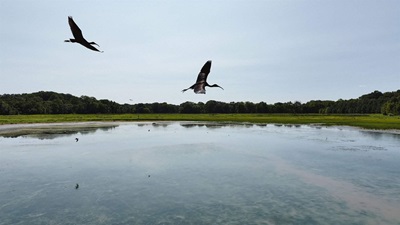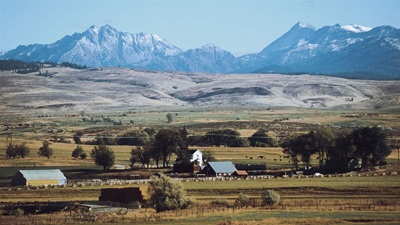From Planning to Progress—States Take Action to Become More Disaster Resilient
Programs from Maine to Washington build momentum through measurable success

Editor’s Note: This article was updated Aug. 26, 2025, to name Washington in the subhead instead of Texas.
As the United States braces for a hotter-than-average summer and an above-normal 2025 Atlantic hurricane season, state governments are preparing for the months of extreme weather ahead—and planning for the disasters of decades to come. A recent meeting of the State Resilience Planning Group (SRPG), convened by The Pew Charitable Trusts, spotlighted the comprehensive disaster resilience initiatives of three states—Maine, South Carolina, and Washington—and the ways they are addressing long-term disaster risks, incorporating input from stakeholders, such as community leaders and businesses, and coordinating interagency action. Guided by resilience plans, these states are building infrastructure that can better withstand disasters and creating programs that help communities understand and respond to risk while developing frameworks that measure progress and track success.
From planning to action in Maine
Brian Ambrette, the director of the newly formed Maine State Resilience Office, explained how his team initiated stakeholder engagement and planning, worked to attract funding and build capacity, and then hit the ground running to build community and infrastructure resilience.
In the wake of a trio of severe storm systems over three weeks in the winter of 2023 and 2024, Maine’s governor established the Maine Infrastructure Rebuilding and Resilience Commission by executive order. The commission spent a year developing the Infrastructure Resilience Plan, which underscores an urgent need for Maine to become more proactive and self-resourced in reducing future storm risk. This built on the state’s climate action plan, Maine Won’t Wait, which was released in 2020 and updated in 2024; it prioritized community resilience programs and the establishment of a new infrastructure resilience fund.
Both plans informed legislation enacted in April. The law’s disaster resilience provisions include a $15 million program to help homeowners protect their homes by floodproofing basements and strengthening roofs against wind damage, and a $5.75 million initiative to improve flood models, maps, and data-sharing. A $69 million influx of funding from the National Oceanic and Atmospheric Administration’s Climate Resilience Regional Challenge also supports expanded state programs, including Maine’s Community Resilience Partnership.
Launched in December 2021, the partnership now helps 263 communities plan for the aftermath of local disasters and identify priority projects to help build resilience to extreme storms, flooding, rising sea levels, and public health threats. The program has grown far beyond its initial goal of assisting 100 communities in its first year; it has awarded $15.8 million in grants for 276 climate resilience projects and established a network of regional assistance providers that help communities that are rural, underserved, or broadly lack adequate staff, expertise, and resources. “We're excited to see these funding opportunities coming together, reinforcing one another, and building upon both Maine Won’t Wait and the Infrastructure Resilience Plan. These plans and funding will form a coordinated response to future storms and help us think holistically and long term about the challenges and the opportunities we have as a state,” Ambrette told meeting attendees.
Measuring resilience in Washington and South Carolina
When directing resources toward resilience programs and projects, it is essential that states understand their return on investment. “A measurement framework is important for tracking if your state or your government is making progress on climate resilience overall, or on a specific initiative or action,” explained Carlie Stowe, a climate resilience specialist with the University of Washington Climate Impacts Group (CIG). Stowe shared findings from a new paper—published by CIG researchers, the University of South Carolina’s Hazards Vulnerability and Resilience Institute (HVRI), and Pew—that provides a behind-the-scenes view of how to develop resilience measurement frameworks.
In Washington, 2023 legislation instructed 10 state agencies to craft a new climate resilience strategy and charged CIG with developing resilience metrics. Stowe explained that her team developed a unique measurement framework tailored to the state’s goals that balanced measuring how the state is implementing their plan (process-based metrics, like the amount of resilience funding distributed) with tracking overall progress toward resilience goals (outcome metrics, such as measuring reduced risk from extreme weather hazards in different communities).
In contrast, HVRI and the South Carolina Office of Resilience (SCOR) adapted an existing framework to measure how effective the implementation was of the state’s 2020 Strategic Statewide Resilience and Risk Reduction Plan. Additionally, the Baseline Resilience Indicators for Communities will help SCOR learn how well-positioned South Carolina’s communities already are for disaster response and recovery, looking across factors such as the number of homes enrolled in flood insurance, the amount of land that is unpaved, or the existence of wetlands that act as a natural flood buffer. These indicators can be recalculated over time to determine whether resilience is increasing in different communities or sectors.
University partners provided critical analytical and technical expertise for state resilience offices in both Washington and South Carolina. “Having HVRI already local and working with us was a huge help with our resilience plan,” said Bryan Rabon, data coordination manager for SCOR. “If you can find experts to help, it’s worth every penny.”
States like South Carolina, Maine, and Washington show the power of comprehensive resilience plans to pinpoint vulnerabilities across communities and economic sectors, and recommend policy change and new funding that can fill preparedness gaps. Resilience offices are setting and advancing goals, measuring progress, and then using the information to learn which approaches are most effective. The challenges—including lack of data, staff capacity, and funding, along with uncertain national policy changes—loom large, but states are building their own momentum, cultivating in-state resilience expertise, and showing returns on investment.
Kristiane Huber works on climate resilience initiatives for The Pew Charitable Trusts’ U.S. conservation project.














